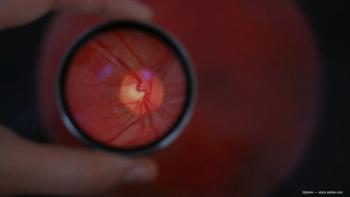
Subretinal fluid protective of vision, CATT study finds
Subretinal fluid was associated with better visual acuity, whereas greater thickness of the subretinal tissue complex was associated with worse visual acuity in the second year of the Comparison of Age-related Macular Degeneration Treatment Trials.
Take home
Subretinal fluid was associated with better visual acuity, whereas greater thickness of the subretinal tissue complex was associated with worse visual acuity in the second year of the Comparison of Age-related Macular Degeneration Treatment Trials.
By Michelle Dalton, ELS; Reviewed by Sumit Sharma, MD
Durham, NC-Eyes with foveal intraretinal fluid, abnormally thin retinas, and those developing a geographic atrophy or scar had the worst visual acuity in an assessment of morphologic features associated with visual acuity in the second year of the Comparison of
The purpose of the study was to look at “which factors on
“That's the main goal,” Dr. Sharma said. “We expected certain things-that having fluid gives patients worse vision, [or] that having a scar or geographic atrophy gives patients worse vision.”
What the group did not expect to find, however, was that subretinal fluid under the fovea was actually protective of vision.
Several theories exist about the potential reasons why subretinal fluid in that location seems to be protective, “but some think it may be because we’re drying out those patients too much and it’s leaving them more atrophied,” Dr. Sharma said. “Even when we controlled and accounted for that with multivariate regression models, we still found subretinal fluid is protective.”
Eligibility criteria required evidence on fluorescein angiography and OCT of choroidal neovascularization (CNV) secondary to AMD and visual acuity between 20/25 and 20/320 in the study eye, the researchers said.
Treatment was assigned randomly to either ranibizumab (Lucentis, Genentech) or bevacizumab (Avastin, Genentech) and to three different dosing regimens over a 2-year period. A linear regression model was used to provide estimates of mean visual acuity adjusted for all significant morphologic features.
Among 1,185 CATT participants, 993 (84%) had fluid on OCT at baseline and 2-year follow up data. At 2 years, the mean visual acuity (letters) of eyes varied substantially by the type of subfoveal pathology on FP: 70.6 for no pathology, 74.1 for fluid only, 73.3 for CNV or pigment epithelial (RPE) detachment, 68.4 for nongeographic atrophy, 62.9 for geographic atrophy, hemorrhage, RPE tear, or blocked fluorescence; and 62.9 for scar.
Eyes with subretinal fluid in the foveal center on OCT had better a mean visual acuity of about 71 letters compared with 67 letters in eyes without any fluid (p = 0.006). Eyes with intraretinal fluid in the foveal center had worse mean visual acuity (about 60 letters) than eyes without any intraretinal fluid (70.9 letters; p < 0.0001).
“Developing a scar or geographic atrophy is associated by far with the worst vision of any type of pathology that patients can have with AMD,” Dr. Sharma said.
According to Dr. Sharma, the group was looking for defects. At the 2014 meeting of the American Society of Retinal Specialists, Susan Bressler, MD, suggested that some scarring is being misidentified as geographic atrophy, and that may help explain why some patients don’t dry out.
“Dr. Bressler’s comments are on point,” Dr. Sharma said. “People look at OCT and qualify something as geographic atrophy, but without having the fluorescein to confirm the diagnosis.”
Autofluorescence-which was not used during the CATT study-can more accurately differentiate between scarring and geographic atrophy, Dr. Sharma said.
Sharing the imaging results with patients is “definitely” helpful, according to Dr. Sharma.
“Patients who have undergone multiple injections are keen to look at their OCTs,” he said. “After a while, they may be able to tell if they need an injection or not. We can show them that the fluid may be getting better even if the vision is the same, and that helps bolster our point that without treatment they could become much worse, or have a recurrence of fluid, or even bleed.”
Once physicians can show incremental improvement, or at least stabilization, “people understand that we’re trying to prevent them from getting worse,” Dr. Sharma said.
Regardless of vision, Dr. Sharma recommends treating based on anatomic outcomes.
Moving forward
Investigators are currently evaluating “what the etiology or reason is for better vision with subretinal fluid,” Dr. Sharma said. “That’s a very pertinent question. We’re doing additional analyses and going back and re-analyzing a lot of the data in the CATT study.”
Others have found similar things in the other large AMD studies, including the U.K.’s Inhibition of VEGF in Age-related Choroidal Neovascularization (IVAN) study, Dr. Sharma said.
It’s almost counterintuitive that retained fluid would be more protective than the complete elimination of the fluid, but “we also don’t want to treat until the patients are so dry they’re developing atrophy,” he said.
“I personally think there is early atrophy that is clinically undetectable-that maybe we’re missing changes in the photoreceptors when we’re completely drying things out,” Dr. Sharma said.
Reference
1. Sharma S, Toth CA, Daniel E, Grunwald JE, et al. Macular morphology and visual acuity in the second year of the Comparison of Age-related Macular Degeneration Treatments Trials (CATT). Paper presented at: Association for Research in Vision and Ophthalmology, May 5, 2014; Orlando.
Sumit Sharma, MD
This article was adapted from Dr. Sharma’s presentation during the 2014 meeting of the Association for Research in Vision and Ophthalmology. Dr. Sharma does not have any financial disclosures related to his comments.
Newsletter
Don’t miss out—get Ophthalmology Times updates on the latest clinical advancements and expert interviews, straight to your inbox.








































